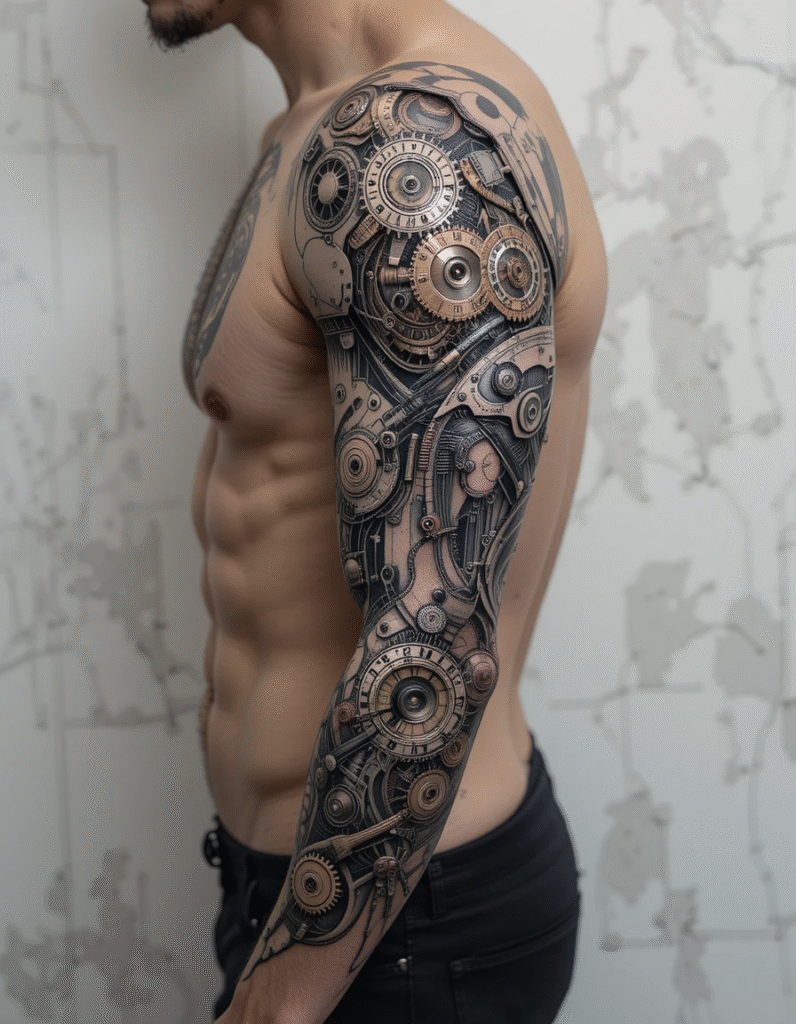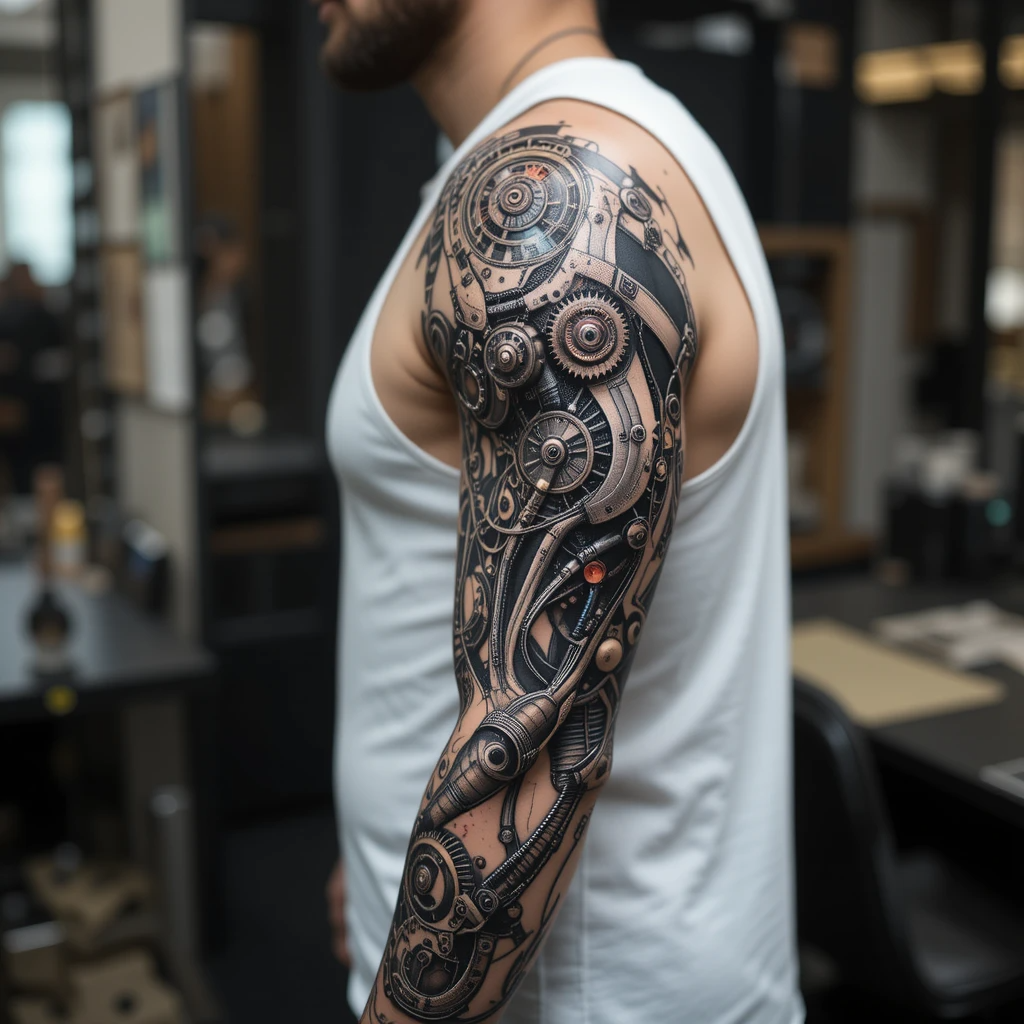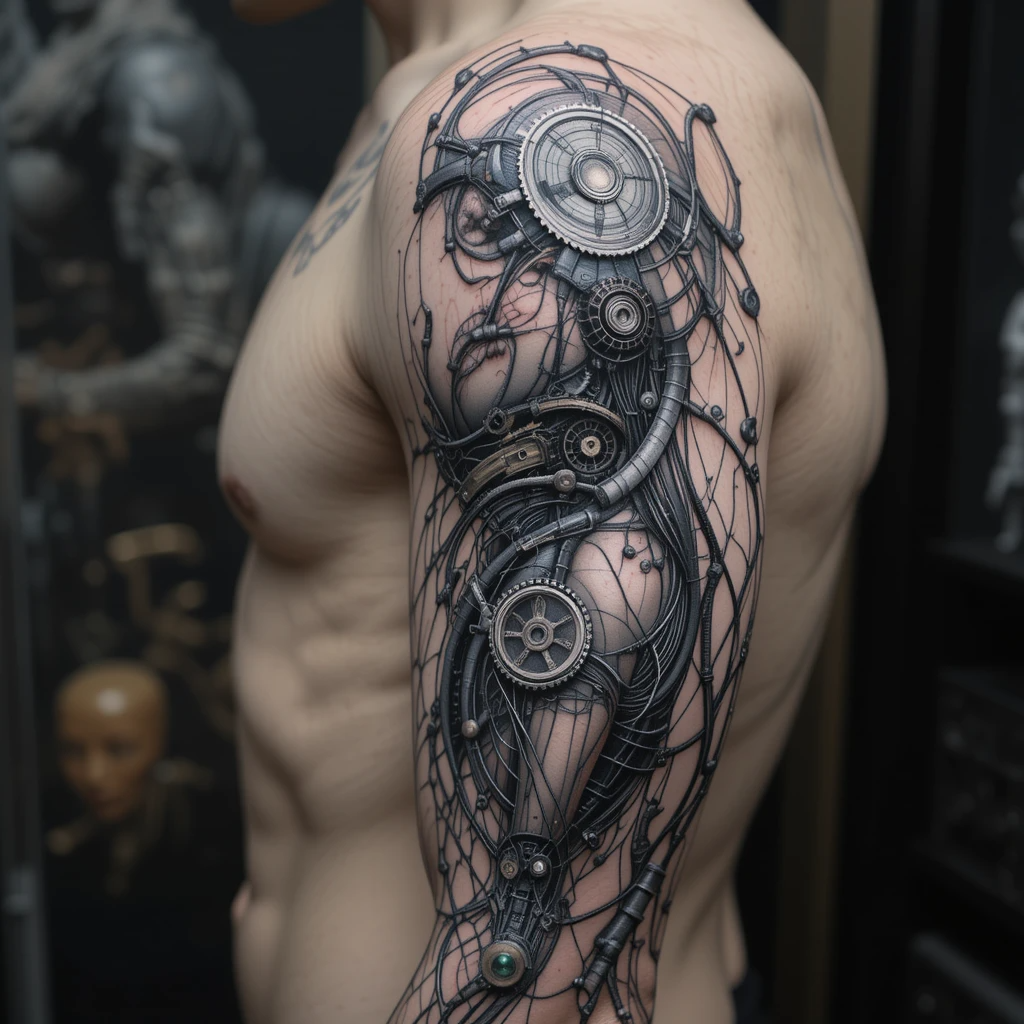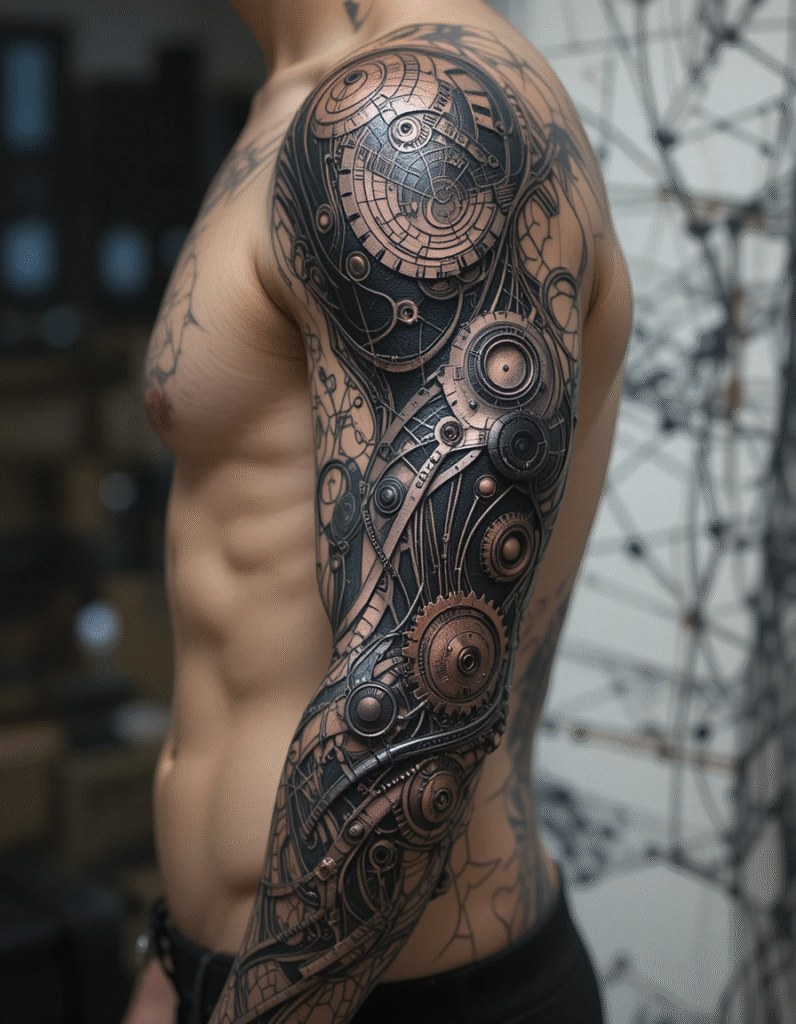In the realm of tattoo artistry, few styles capture the imagination quite like biomechanical tattoos. These intricate designs blur the line between human anatomy and mechanical engineering, creating the stunning illusion that complex machinery lies just beneath the surface of the skin. Born from the intersection of science fiction aesthetics and masterful tattoo craftsmanship, biomechanical tattoos represent one of the most technically challenging and visually striking forms of body art.
The Origins of Biomechanical Art
The biomechanical aesthetic traces its roots to the visionary work of Swiss artist H.R. Giger, whose nightmarish yet beautiful fusion of organic and mechanical forms gained worldwide recognition through the “Alien” film franchise. Giger’s dark, sexually charged imagery of beings that were simultaneously biological and technological laid the groundwork for an entire artistic movement that would eventually find its way into tattoo culture.
In the tattoo world, biomechanical designs began gaining popularity in the 1980s and 1990s as artists sought new ways to push the boundaries of what was possible with ink and skin. The style offered tattoo artists an opportunity to showcase their technical skills while creating pieces that seemed to transform the human body into something altogether more complex and mysterious.

The Art of Illusion
What sets biomechanical tattoos apart from other styles is their commitment to creating believable three-dimensional illusions. These aren’t simply drawings of machines placed on skin – they’re carefully crafted optical tricks that convince the viewer that they’re seeing actual mechanical components integrated into the wearer’s anatomy.
Depth and Dimension: Master biomechanical tattoo artists use sophisticated shading techniques, strategic highlighting, and careful attention to light sources to create the illusion of depth. Gears appear to recede into the skin, while pistons and cables seem to emerge from beneath the surface.
Anatomical Integration: The most successful biomechanical tattoos work with the body’s natural contours and muscle structure. Artists design pieces that follow the natural flow of tendons and muscles, making the mechanical elements appear as if they’re actually powering the body’s movement.
Mechanical Accuracy: While artistic license is certainly employed, the best biomechanical tattoos demonstrate a solid understanding of how real machinery works. Gears mesh properly, cables follow logical paths, and mechanical systems appear functional rather than purely decorative.

Common Elements and Motifs
Biomechanical tattoos draw from a rich vocabulary of mechanical and technological imagery:
Clockwork Components: Gears, springs, and clockwork mechanisms are among the most popular elements, offering artists opportunities to create intricate patterns while maintaining the illusion of functional machinery. The circular nature of gears also complements the body’s natural curves.
Industrial Machinery: Pistons, hydraulic systems, cables, and pipes create the impression of powerful mechanical systems. These elements work particularly well in sleeve tattoos where they can span large areas and create complex interconnected systems.
Electronic Elements: Circuit boards, wiring, and electronic components represent the modern evolution of biomechanical art, reflecting our increasingly digital world.
Hybrid Anatomy: Some designs incorporate elements that appear to be cybernetic replacements for natural body parts – mechanical joints, artificial muscles, or technological augmentations that enhance human capability.
Technical Mastery Required
Creating convincing biomechanical tattoos demands exceptional technical skill from the artist:
Advanced Shading Techniques: The three-dimensional illusions that define this style require masterful control of light, shadow, and gradation. Artists must understand how light interacts with different materials – the gleam of polished metal versus the matte finish of worn components.
Precision Line Work: The mechanical elements in these tattoos often require incredibly precise linework to maintain the illusion of manufactured precision. A single wobbly line can break the spell and make the entire piece appear less convincing.
Compositional Planning: Biomechanical sleeves and large pieces require extensive planning to ensure that all elements work together cohesively. The artist must consider how the design will flow across different body parts and how it will look from various angles.
Color Theory Understanding: While many biomechanical tattoos are executed in black and grey, those incorporating color require deep understanding of how different materials reflect light and how metallic surfaces appear under various lighting conditions.
Placement and Design Considerations
The success of a biomechanical tattoo often depends heavily on placement and how the design interacts with the body’s natural architecture:
Sleeve Tattoos: Full and half sleeves are among the most popular placements for biomechanical designs. The cylindrical nature of arms lends itself well to the illusion of mechanical components running along or through the limb.
Shoulder and Chest Pieces: These areas offer large, relatively flat surfaces that can accommodate complex mechanical systems while following the natural contours of muscle groups.
Back Pieces: The broad expanse of the back allows for massive, intricate biomechanical designs that can incorporate spinal elements or create the illusion of an entire mechanical infrastructure.
Joint Integration: Particularly effective biomechanical tattoos often focus on natural joint areas – elbows, knees, shoulders – where the illusion of mechanical augmentation feels most believable.

Symbolism and Personal Meaning
Beyond their visual impact, biomechanical tattoos often carry deep personal significance:
Human Enhancement: For many wearers, these tattoos represent the desire for self-improvement or the belief that humans can transcend natural limitations through technology.
Industrial Heritage: Some choose biomechanical designs to honor careers in engineering, manufacturing, or other technical fields.
Futuristic Vision: These tattoos can represent fascination with technology’s potential and humanity’s technological future.
Strength and Power: The imagery of powerful machinery can symbolize inner strength, resilience, or the ability to overcome obstacles through determination and engineering.
The Evolution of Style
Modern biomechanical tattooing continues to evolve, incorporating new technological imagery and artistic techniques:
Digital Integration: Contemporary artists are beginning to incorporate elements from our digital age – holographic displays, augmented reality interfaces, and nanotechnology concepts.
Steampunk Influences: The steampunk aesthetic has influenced biomechanical tattooing, introducing Victorian-era mechanical elements and brass-toned color schemes.
Organic Integration: Some modern interpretations blur the line even further by incorporating more organic elements, creating designs where biological and mechanical components appear to grow together naturally.
Choosing the Right Artist
Biomechanical tattoos represent one of the most technically demanding tattoo styles, making artist selection crucial:
Portfolio Review: Look for artists whose portfolios demonstrate consistent ability to create convincing three-dimensional illusions and show understanding of mechanical systems.
Technical Skill Assessment: Pay attention to the artist’s shading work, line precision, and ability to create realistic metallic textures.
Experience with Large Pieces: Since biomechanical tattoos often work best as large, connected pieces, seek artists experienced in planning and executing complex, multi-session projects.
Maintenance and Aging
The intricate details that make biomechanical tattoos so impressive also make proper care essential:
Sun Protection: The fine details and subtle shading in these tattoos can be particularly susceptible to sun damage, making consistent sunscreen use crucial.
Touch-up Considerations: The precision required in biomechanical work means that touch-ups should only be performed by artists skilled in the style.
Long-term Planning: Consider how the design might age and whether future additions or modifications might be desired.
The Future of Biomechanical Art
As technology continues to advance and become more integrated into daily life, biomechanical tattoos remain relevant and compelling. They represent not just artistic achievement but also our ongoing fascination with the relationship between humanity and technology. Whether viewed as artistic masterpieces, personal statements, or glimpses into possible futures, biomechanical tattoos continue to push the boundaries of what’s possible in tattoo artistry.
These remarkable pieces stand as testament to both human creativity and technical skill, transforming the body into a canvas for exploring our relationship with the mechanical world. In an age where the line between human and machine continues to blur, biomechanical tattoos offer a unique way to externalize our internal relationship with technology, wearing our fascination with mechanical precision and power literally on our sleeves.


